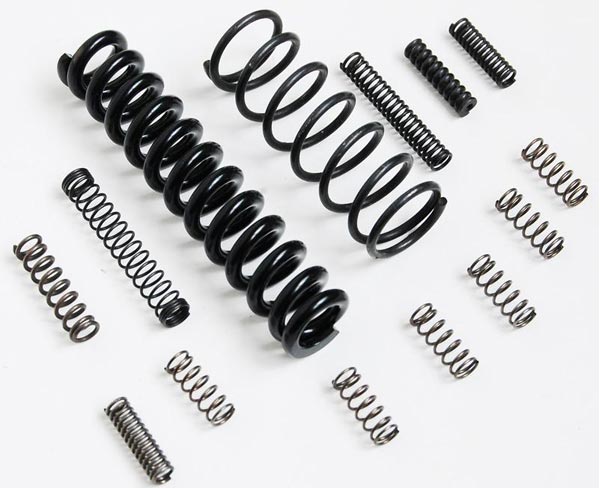Spring Manufacturing Process
The Spring Manufacturing Process refers to the process of turning the spring material into a finished spring and flowing through each process in sequence. Due to different spring materials, spring types and processing methods, the process regulations of coil springs are also different. However, their basic technological process is: coil spring-heat treatment-end processing-surface treatment.
Below, several common typical technological Spring Manufacturing Process are introduced.
1.Use cold drawn spring steel wire to make compression coil spring
For lathe coiled springs, after the coiling process, several connected springs must be separated into a single spring after the coiling process.
For some important springs, a blank height classification process can be added before grinding the end face to ensure the grinding quality. The grinding process can also be divided into two processes: rough grinding and fine grinding, and deburring or chamfering is performed after rough grinding.
2.Use cold drawn spring steel wire to make tension coil spring
For the manufacture of tension coil springs, there are special automatic spring coiling machines in foreign countries. For some typical shackles, the coiling process can be completed at one time. However, in China, such machine tools have not yet been produced. Tension spring shackles are manufactured with some special molds, which is a special process.
It is worth noting that the stress relief and tempering process after coiling the spring is to eliminate the residual stress generated during the winding process, and the tempering process after the shackle is made to eliminate the internal stress generated during the production of the shackle. Although these two processes have the effect of eliminating internal stress, they cannot be combined into one process, because the previous tempering process also has a “shaping” effect to ensure the relative position accuracy of the shackles. And the heating temperature of the subsequent tempering process must not be higher than the previous tempering temperature.
Unlike compression springs, extension springs are generally not subjected to “force pulling” treatment. Since it is difficult for the pellets to be sprayed onto the inner surface of the spring, no shot peening is performed.

3.Use cold drawn spring steel wire to make torsion coil spring
Similar to extension springs, torsion coil springs are manufactured in foreign countries with special automatic spring coiling machines. For some typical torsion arms, the spring coiling process can be completed at one time. However, at present, there is only a straight-tail spring coiling machine in China, and the torsion arm must be completed in a special process with a special mold.
At present, there are two typical processes for the production of torsion coil springs in China. One is to cut the material to a certain length first, and then perform other processes such as coil springs. The process flow is similar to the tension spring, but it is different: the tension spring is to make the hook and the loop, and the torsion spring is to make the torsion arm.
Since the residual stress generated during the coiling of the spring is in the opposite direction to the working stress, the tempering process is often omitted to allow these beneficial residual stresses to reduce the peak of the working stress. However, the tempering treatment is beneficial to stabilize the crystal grain structure of the spring material, and can reduce the deformation of the spring torsion arm caused by collision during transportation and other processes.
Strong torsion treatment is also a process arranged for a very small number of special torsion springs.
4. Manufacture of coil springs from spring steel wire supplied in an annealed state
The alloy spring steel wire supplied in the annealed state is mainly used to manufacture compression coil springs. The process flow is different from the above mainly in that it needs to be quenched and tempered after forming. The end of the spring needs to be normalized from time to time, and the other processes are basically the same. .
5. Process flow of hot rolled large spring
Springs with a material diameter greater than 12mm, often called large springs, are generally manufactured by thermoforming. The hot coil spring is basically a compression coil spring.
Hot coil springs are all cored coil springs. For the rolled conical spiral compression spring, it is difficult to “open” (rolling out the pitch) during rolling, so in the calibration process, there is also the task of opening. In addition, in order to ensure the quenching temperature, the correction process must be accurate and rapid. Otherwise, it must be reheated during quenching. In order to improve the fatigue life of hot-coiled springs, shot peening should be carried out as far as possible when possible.






